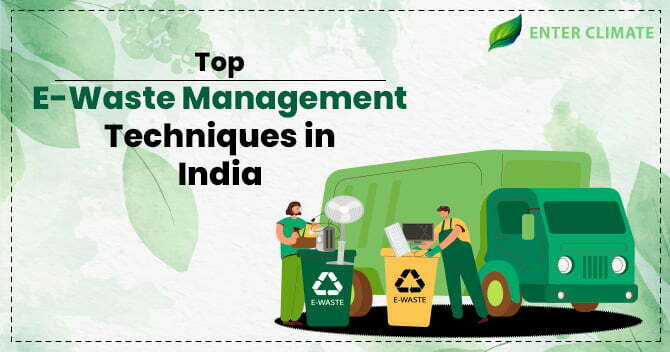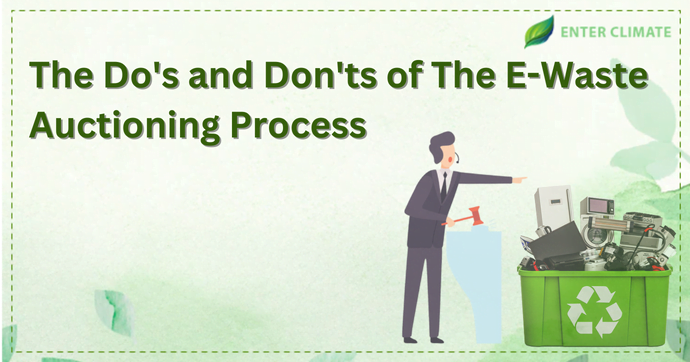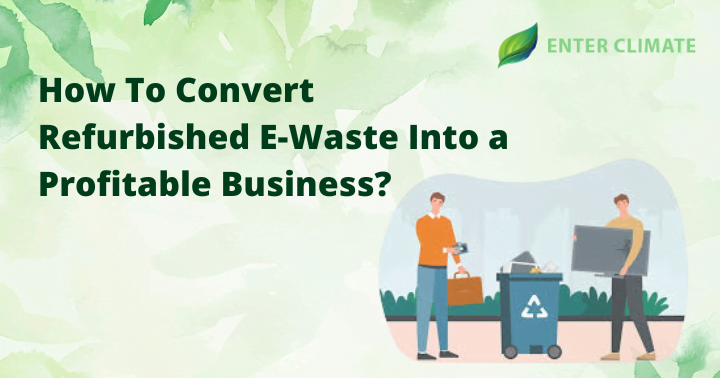Top E-Waste Management Techniques in India: An Overview
 26 Jul, 2022
26 Jul, 2022 
E-waste comprises waste generated when end–of–life of Electronic and electrical equipment (EEE) is discarded by the user with no intent to reuse. By definition, E-Waste Management is the recycling, reuse and disposal of the waste generated by used electronic and electrical devices and appliances. Therefore, e-waste management techniques are based on extracting the maximum value from whatever functional or repairable components can be separated from the waste. Examples of e-waste include old and non-functional computers and telecommunications equipment, consumer electronic devices and solar panels, fridges, TVs, monitors and screens, cooling equipment etc. Some categories of E-waste, discarded by the electronics and telecommunication segment, also have many valuable metals like copper, silver, gold etc. Recycling e-waste can help reclaim these metals and prevent their loss. Some biochemical hazards like leaching are also associated with the unsafe disposal of electrical and electronic items. E-waste management techniques can prevent such chemicals and heavy metals from entering landfills and, ultimately the biotic factors of the ecosystem.
Popular E-waste Management Techniques
E-Waste Management techniques are generally based on three approaches- Reduce, Reuse and Recycle. While the reduction in the use of EEE will lead to less waste generation, which might not be a good outcome considering the purpose of having an e-waste business, the other two approaches, i.e. recycling and reusing, can definitely take the shape of a successful business based on or around models of e-waste management. In the following sections, some of the popular areas in which successful e-waste business models have emerged in India have been detailed.
Reusing Approach in E-Waste Management
Reusing e-waste means redeploying a discarded EEE that has exhausted its utility in the eyes of the previous owner to a new owner on acceptable prices and conditions. Pre-owned electronic devices discarded by the first owners due to minor faults or a decrease in performance can be put to good use by other people willing to use them. Starting a business centred around reusing old and functional EEE is a feasible business option as it targets buyers with limited purchasing power. Also, if the need for the item is temporary, the consumer will choose to use an old or used product rather than buy a new one.
Laptops and PCs, cameras, AC, medical equipment, lab equipment, photocopy machines, etc., are costly. These old devices can be purchased in e-waste auctions and can find buyers easily after proper repair and refurbishment. This is one of the many reasons why the second-hand electronics market has grown into a big market in the country today. Apart from being cheap, these devices also attract consumers who desire to own the latest technology but cannot afford new devices. High-end laptops, mobiles, gaming consoles, etc., are quite popular among youngsters with limited purchasing capacity and therefore, are looking for second-hand devices. In the subsequent section, we will try to understand the opportunities of E-Waste Management Techniques in the area of reuse.
RepairingBusiness
Old and non-functional EEE can often be repaired and refurbished with some effort. While most consumers today choose to toss out the old unit and buy a new replacement because it seems cheaper and less hassle, there are also buyers who are searching for such products. An E-waste management technique can reap benefits from both practices. In India, repair businesses have been prevalent, and repair shops are a common sight. It can be in the shape of a local business owner or a company-authorised repair centre. It may not be news that a large section of Indian buyers prefer to get their faulty devices repaired to utilise their devices to the full extent before replacing them. Some also prefer to buy repaired items simply because it costs less. A repairing business can be taken to the next level by further utilising the repairing platform and selling it into the second-hand market. These businesses can be in the form of component-level electronics assembly repair units and facilities that maintain an inventory of old parts that are difficult to find.
Refurbishing Business
Refurbishing Business is different from repairing business as the reworking approach on the e-waste is different in both cases. The refurbishing business always has a broader scope than the repair business and is one of the most promising e-waste management techniques. While a repairing business aims to fix only the particular issue in the device, a refurbishing business focuses on making the product new-like. Refurbishing is a lengthier process, too and requires expertise. It can include one or more of the steps like cleaning, lubrication, replacement of consumable items repairs, doing a firmware upgrade or factory reset, and cosmetic improvements.
Recycling Approach in E-Waste Management
An E-waste recycling business can include any or all steps of E-Waste management techniques, ranging from collection and transportation to the processing, recycling and disposal of EEE waste. In India, this segment of waste processing is dominated by the informal sector. There are vast possibilities for e-waste recycling supported by the increasing demand for electronic goods and their indiscriminate disposal afterwards. The present e-waste recycling units in the informal sector can also get authorised and unlock their vast potential in the business as authorised collectors, dismantlers, recyclers and PROs. The following sections will elaborate on the top e-waste management techniques from the recycling segment.
Collection and Transportation of E-waste
Collection is the first stage in E-waste Management. One might ask how can a business develop around such a common activity as waste collection. Well, e-waste has a value that the owner is usually unaware of or deliberately chooses to ignore. Simple Issues like software obsolescence, cracks, scratches, misaligned body, reduced performance, or some technical malfunctioning in an otherwise good product can make the user discard it and buy a new product. But such e-waste is not all waste and the e-waste collector is the first entity that handles this waste. E-waste collectors have the chance to turn such waste into wealth with these forms of e-waste management techniques. Following are some of the E-Waste management techniques that have been built around e-waste collection.
Collection and deposit centres: After the introduction of EPR in India, companies increasingly rely on a collection and exchange policy as an e-waste management technique whereby they implement measures to take back old gadgets when a customer buys a later version. Mobile and electronics exchange is typical these days, and both offline and online market has this option. The manufacturers and sellers engage collection specialists to do this work. A few recycling companies have also set up deposit return/ refund System (DRS) facilities in the form of drop-off points for products such as cell phones and tablets, after which they are sent to further stages of recycling. This model can be replicated in areas where such collection is non-existent or depends on local raddiwalas and kabadiwalas by utilising their knowledge of waste collection.
Door to Door E-waste Collection: The E-Waste management techniques involving collection are being initiated by government agencies to prevent e-waste from reaching landfills or the informal sector. In this approach, the municipal bodies encourage the local population to sell their e-waste from the convenience of their homes to collectors. Private collectors and transporters are hired for this purpose. This scheme has been implemented in a few cities like Delhi with much success. Many private entities have realised the potential of such initiatives in waste management and started to implement similar waste collection models.
Segregation and storage of E-waste
Segregation of e-waste is done with a focus on the value of the component in the e-waste. The age of the product does not matter much in this form of E-Waste management technique. Segregation, therefore, calls for a trained eye. New entrepreneurs and existing traders can increase their revenue by building segregation and storing capabilities along with their existing e-waste business. However, the unit must be built on the guidelines provided by CPCB and SPCB and follow the standard operating procedure(SOP) in the E-waste Management Rules.
While primary segregation is done by the small group of traders who buy the waste from the Kabbadiwalas, secondary segregation, as per the demand of dismantlers, can be done by experienced and authorised segregation and small dismantlers. Small traders collect a lot of e-waste and dismantle particular components from the waste (for example, PCB from EEE, CRT from monitors etc.)and sell them to the big traders and wholesalers dealing in e-waste. Anyone with limited resources or finances can start with this model and gradually expand the scope of their business afterwards.
Storage of E-waste also needs proper space and compliance with storage norms in the e-waste rules. E-waste traders, dismantlers and disposal units require storage facilities. Many entities like the hospital, government agencies, and scientific labs store their old devices and equipment for the development of a process for its recycling or reuse in the near future. They need storage facilities to store their e-waste for durations that may exceed the storage norms specified in the E-waste Rules.
Dismantling of e-waste
Dismantling is a part of e-waste recycling that involves a person or an organisation disassembling used electrical and electronic equipment into its components. Any dismantling operation without authorisation from the concerned SPCBis considered as causing environmental damage and attracts penal provisions as per the Environment (Protection) Act, 1986. Dismantler can apply for Authorisation in Form- IV and obtain consent to establish (CTE) and to operate (CTO) under the Water Act, 1974[1] and the Air Act, 1981.
Setting up a Producer Responsibility Organisation (PRO)
The concept of Producer Responsibility Organisation (PRO) was introduced to manage the EPR liabilities of PIBOs. PRO is doing the recycling function on behalf of the PIBOs in e-waste and plastic packaging waste recycling. PROs have been in massive demand in recent times, and such facilities have risen as one of the top E-waste management techniques after the Single-use-Plastic Ban and the 2022 Amendments of Plastic Waste Management Rules. Many dismantlers and recyclers of E-waste have developed themselves into PRO after gaining authorisation and installing the necessary infrastructure. PROs also operate an e-waste take backs system on behalf of Producers/OEMs and ensure collection and transportation to authorised treatment and recycling centres.
Conclusion
The boom in the EEE market and hunger for the latest devices among all age groups has led to increased discarding of functional and valuable E-waste in the past decade. With this increased demand,the need for upgrading EEE to the latest configuration, and the introduction of artificial intelligence and the internet of things have also led to high obsolescence of EEE, and this trend will continue uninterrupted in the future. Many business opportunities have developed in and around E-Waste management techniques, and there is scope for further growth too. India chooses to export the e-waste for processing and extraction of valuable metals simply because the current capacity cannot handle the sheer volume of e-waste being generated. E-waste management techniques create job opportunities for unskilled workers like kabadiwalas, raddiwalas, ragpickers, dismantlers, etc., who are involved in collecting, dismantling and processing varieties of e-waste.













